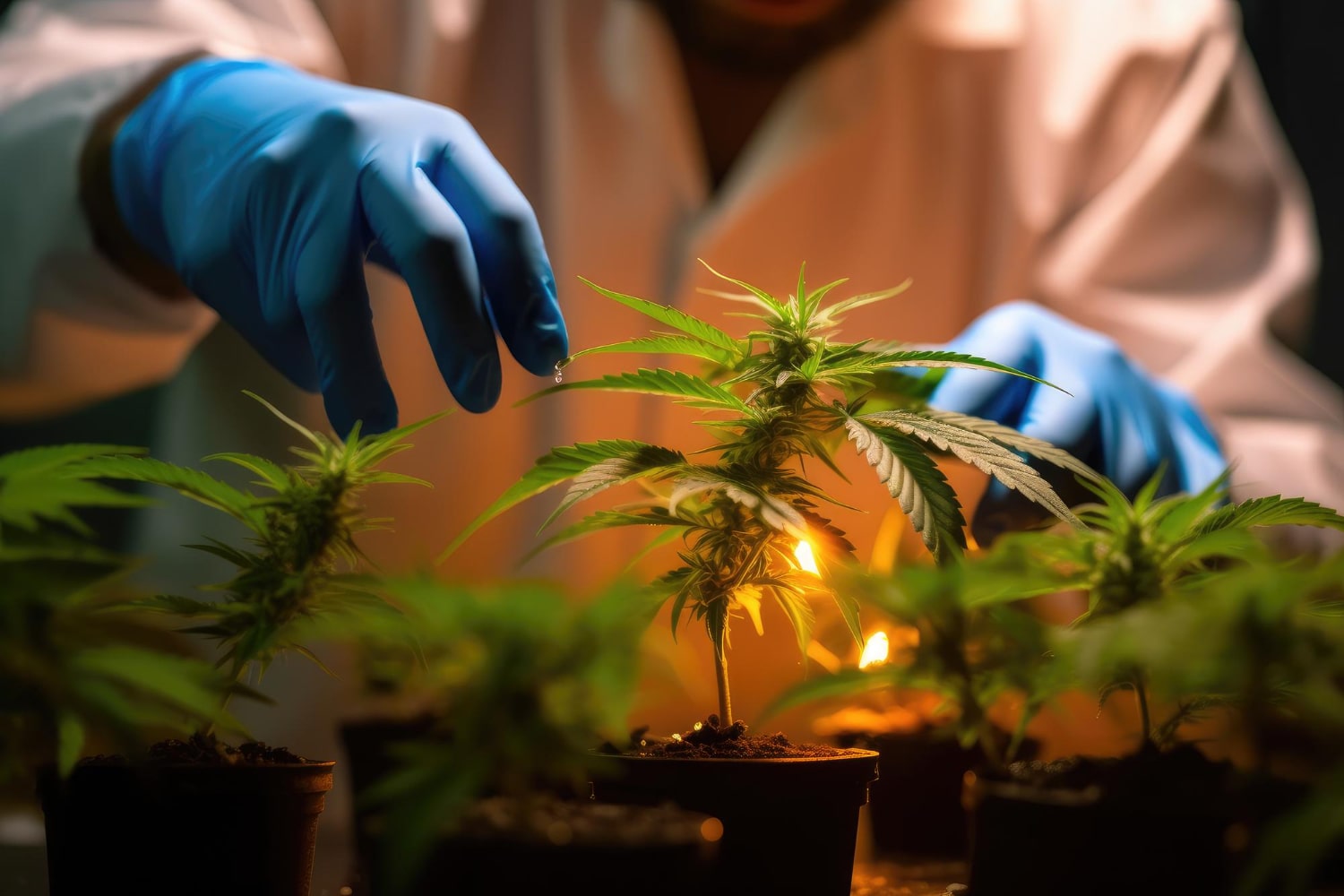Consistent genetics, rapid propagation, controlled growth, and preservation of desirable traits are just a few ways cloning offers several benefits in various agricultural fields. From avoiding male plants to keeping your favorite strain genetics always on hand, cloning cannabis plants in particular offers cannabis growers a world of benefits. So let’s look into how to clone cannabis.
The Science Behind Cannabis Cloning
Located within the growing tips on the branches of the cannabis plant is a tissue region called meristem that contains undifferentiated cells. These cells are special because they can develop into any type of plant tissue (roots, stems, and leaves).
While agents such as rooting gels can help encourage these undifferentiated cells to form into new roots that allow them to become their own plant, various plant hormones, primarily the auxins, will naturally encourage it.
There are many ways for the auxins to encourage root cell differentiation and formation. Gravity alone promotes it because when a cutting is taken and placed in a horizontal or upside-down orientation (away from the natural gravity response), auxin distribution is altered. This process is known as gravitropism.
Materials Needed for Successful Cloning
While you only need a cup of water to successfully clone, having a few other materials on hand can greatly increase your success rates. Now, you will not need all of these items to consistently clone new cannabis plants, so let’s look at what each can offer to see which ones are right for you.
- Nutrient-rich growing medium/Cloner – While you can place your cuttings in cups of water, a seedling tray filled with clay pellets or rockwool can encourage root growth while reducing chances of rot. You can take this as far as buying a cloner, which is an all-in-one kit that contains pretty much everything you need for success.
- Water and nutrients – Unlike seedlings, clones don’t have cotyledon leaves that contain nutrients to feed them during their first few days/weeks. You’ll want to give your clones some fertilizer after they have rooted to help get them ready for transplanting.
- Rooting hormones – Rooting gels and powders contain synthetic auxins to promote those undifferentiated cells to turn into root cells. Not only increasing your chances but also speeding up your results.
- Sterilized scissors – Along with ensuring you’re working in a sterilized environment when cloning is using scissors free from germs, etc. Simply wipe down your scissors with isopropyl alcohol first — make sure they are completely dry before using.
- Light — Your clone won’t have much success unless they are getting light. Now, it doesn’t need to be much, with light coming from a window seal often providing an adequate amount.
- Healing pads – Heating pads help stimulate root growth and are excellent options when growing in lower light and colder environments.
The Cloning Process: Step by Step
Selecting Your Mother Plant
It’s best to take your clones from a mother plant that’s still in the vegetative stage but has had 1-2 months to grow. You’ll want about 6-inch clones to start with, so you may want to skip a couple of pruning sessions so your mother plant can grow branches a bit too long for your liking.
Making Your Cuts
Look for unblemished branches that are about 6-10 inches. Then make diagonal cuts (45° angle) just below the node of the branch you want.
Rooting The Cuttings
Before inserting your cutting into its new medium, trim off any huge lower leaves or undesired node points from the new cutting. Additionally, you can remove the tips of any of the large fan leaves up top to promote the cutting to focus on producing roots. This will also be the time you’ll want to add your rooting agent — make sure to follow the label’s instructions.
Monitoring and Caring For
Over the next few days, you’ll want to carefully monitor your cuttings, ensuring their medium is staying wet but not becoming waterlogged. Misting the leaves can help the cutting better absorb water due to lacking roots.
Transplanting
After 1-3 weeks, it’s time to transplant your now clones into their own containers. You will transplant in the same way you would transplant a seedling, however, you will need to be slightly more careful due to clones lacking a tap root.
Caring for Your Cannabis Clones
With the proper setup, which is pretty easy to achieve thanks to cloning kits, etc. caring for your cuttings as they take root and become full-fledged clones is a fairly simple process.
While they will need light, they won’t need as much as your typical seedling. Clones only need about 5,000 lux, whereas seedlings can often be started around 10,000 lux unless issues are seen. Because you will need to adjust light intensity at various times throughout a cannabis plant’s life cycle, having the correct light meter on hand is pretty much essential for optimal results.
Along with providing low light, make sure the medium doesn’t become dry. However, you’ll want to avoid overwatering because plants can rot. As well, it promotes insects and diseases that you will need to be on the lookout for.
Don’t knock yourself if your cuttings don’t root or a clone dies — it’s a very trial-and-error process, and even professionals can struggle to get consistent results. Thankfully, a single mother plant can provide plenty of material for cloning.
Common Mistakes to Avoid When Cloning Cannabis
When you’re not setting yourself up for success, you can take something that’s a fairly simple process and turn it into a nightmare.
Selecting The Wrong Mother Plant
Clones will be nearly identical to the mother plant they come from, so it makes little sense to choose a mother plant that frequently shows health issues or causes you issues. Environmental stressors, along with genetic mutations, can cause clones to not grow exactly like their mother.
Taking Cuttings Too Late In The Game
While it’s possible if done early enough, it’s very tricky to take a cutting from a flowering cannabis plant. This means the cutting will likely need to be reveg, which can cause genetic issues down the line, such as hermaphroditism.
Making Too Many Cuts
It’s easy to get carried away and take too many cuttings from the mother plant. Fortunately, cannabis plants are beasts that can really take a lot of bulling, especially after they have reached a certain size.
Poor Growing Conditions
Without their cotyledon leaves, clones are even more sensitive than seedlings until their roots have had time to properly develop. Keep your environment clean and lights, temperatures, and other environmental aspects stabilized and in the optimal range.
Poor Rooting Medium
If you’re finding your plants are rotting in rockwool or clay pellets, consider adding vermiculite or perlite to improve drainage.
Our Final Thoughts
It’s easy to see how the term “cloning” can freak out new growers who have never tried the process. Thankfully, cloning plants, especially cannabis plants, is such a ridiculously simple process. While you can literally just cut off a branch and place it in water, taking a few other steps can significantly improve your success rates.
Make sure you select the right mother plant, provide optimal light/temperature, and carefully monitor your cuttings for rot, pests, and diseases. If you’re still having issues, consider a rooting agent. Because when you can become a successful cannabis cloner, you’re rewarded with faster turnarounds that consistently deliver high-quality results.
FAQs
Is it easy to clone cannabis?
Cannabis is one of the easiest plants to clone and can be done with minimal effort and cost. While I wouldn’t suggest you try clones if you have never grown a plant before, anyone with a basic knowledge of gardening can clone cannabis.
What is the best method of cannabis cloning?
You can get extremely high success rates by just imploring the practices we discussed above, and most growers will be more than happy with how many clones they can produce. However, micropropagation, also called plant tissue culture, is likely the future of cannabis cloning when it comes to professional settings.
Can you clone cannabis straight into soil?
It is completely fine to clone cannabis straight into a soil medium — some growers/farmers even prefer doing this as it makes future transplanting less risky. Now, you may see more issues during the first week or so, as a soil medium isn’t the best for an unestablished plant to grow in.





